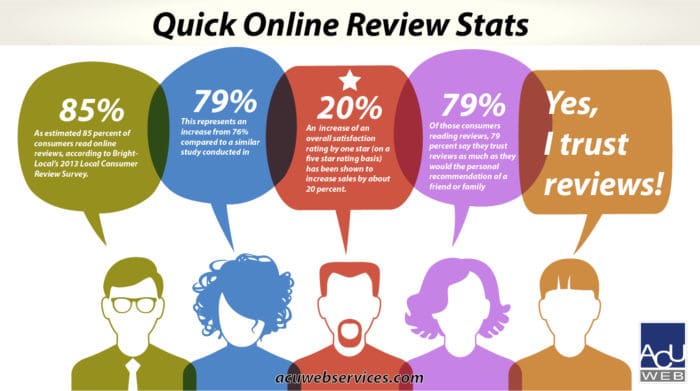Why are Online Reviews so Important?
Reviews on sites such as Yelp or the Better Business Bureau give your customers a chance to voice their opinion about your brand, whether it be good or bad. They also work as a powerful, but often overlooked, form of marketing. Many times, online reviews are the first place potential customers look to find the best product or service to meet their needs. Therefore, making sure that online reviews give a positive impression of your business is crucial.
The Importance of Engaging with Reviews
Actively reviewing and responding to online reviews of your business is a critical aspect of online reputation management. Showing your customers that their thoughts and opinions are being heard can build trust and reduce unnecessary backlash against your company.
Responding to negative reviews can be tricky, though. Your words must be carefully crafted to avoid further hostility from an unhappy reviewer. There’s nothing worse than them believing your company doesn’t care about their feelings, or that they’re not being listened to—these customers will be sure to share their negative experiences with their friends and family, and encourage them to find other alternatives.
Resolving Negative Reviews
Here are some do’s and don’ts of resolving negative online reviews to help you choose the best response in an uncomfortable situation:
Do:
- Relax before responding to a review
- Plan out your response before posting it
- Have a third party look over your response before you post it
- Respond to the review in a timely manner
- Apologize to the customer for their undesirable experience
- Make your response personal
- Show the customer that you would like to make the situation right again, and suggest how you can do that together
- Refer directly to the problem(s) they experienced
- Include contact information in case they have any questions
- Look for the positive in each negative review, and use it a chance to improve
Don’t:
- Ignore or delete the review
- Block the reviewer
- Plant positive reviews to hide the negative review
- Get aggressive or defensive, even if the customer is incorrect
- Use a negative tone in your response
- Explain to the reviewer why they might be wrong or why you might be right
- Use coupons, discounts, or other methods to bribe the customer to change or delete their review
- Use the same response for every review
- Make your response too long; doing so can come off as being defensive
- Refuse to make necessary changes to the company after negative reviews
What next?
You’ve responded to a negative review of your company—what now?
In the worst-case scenario, the customer will continue to leave negative comments about their experience. To resolve this, politely ask them to contact you through a private message to continue your conversation, or leave your contact information and ask them to contact your company to talk through the issue. This will show other potential customers that you are making an effort to reach out to this unhappy reviewer, and are trying to remedy the situation. If the reviewer refuses to do as you asked, at least you did your part.
In the best-case scenario, the reviewer will delete their negative review, or will at least raise their original score. They might also post a second review about the positive customer service experience they had after they posted their review. This may be because you were able to help them work out their problem, and show them that your company is making real changes based on their review. Even better, the reviewer might realize that they could’ve been at fault. Either way, the customer will feel like they were listened to and responded to in a very conscientious way.
By responding to reviews, whether good or bad, you will become more proactive at creating a positive image of your brand. In turn, customers will see that are valued by your company, and you will have a better chance at securing potential future customers.
